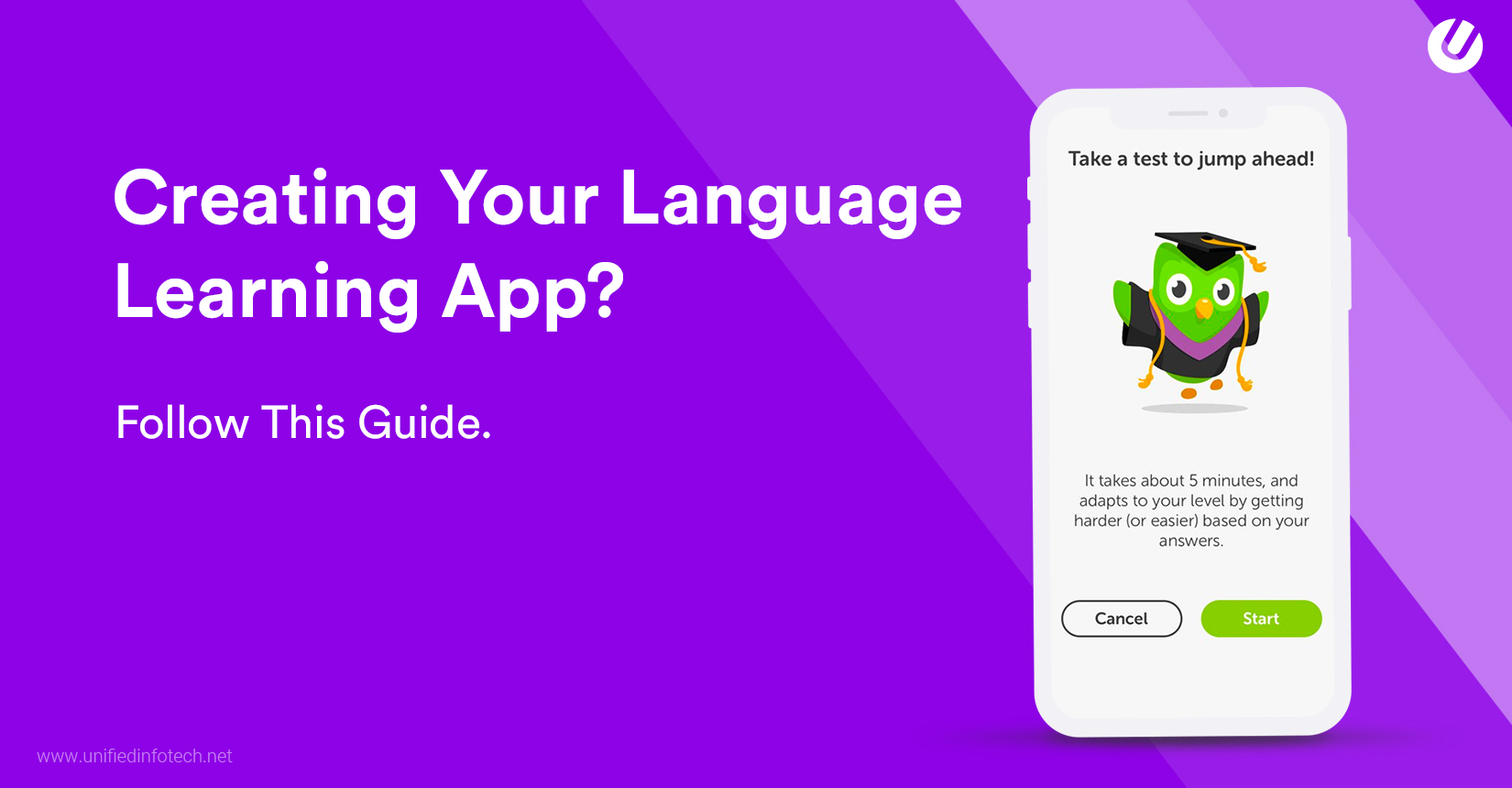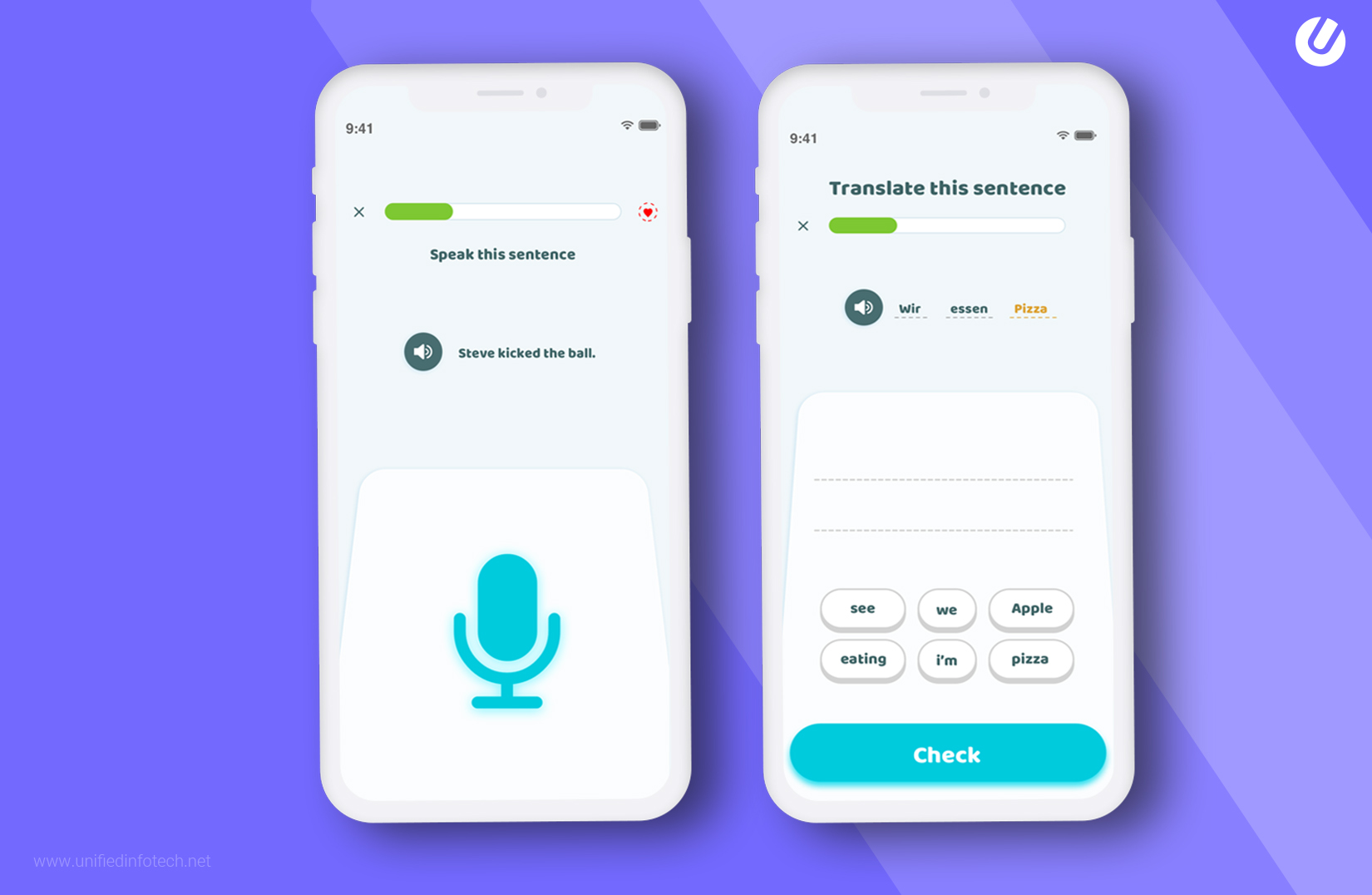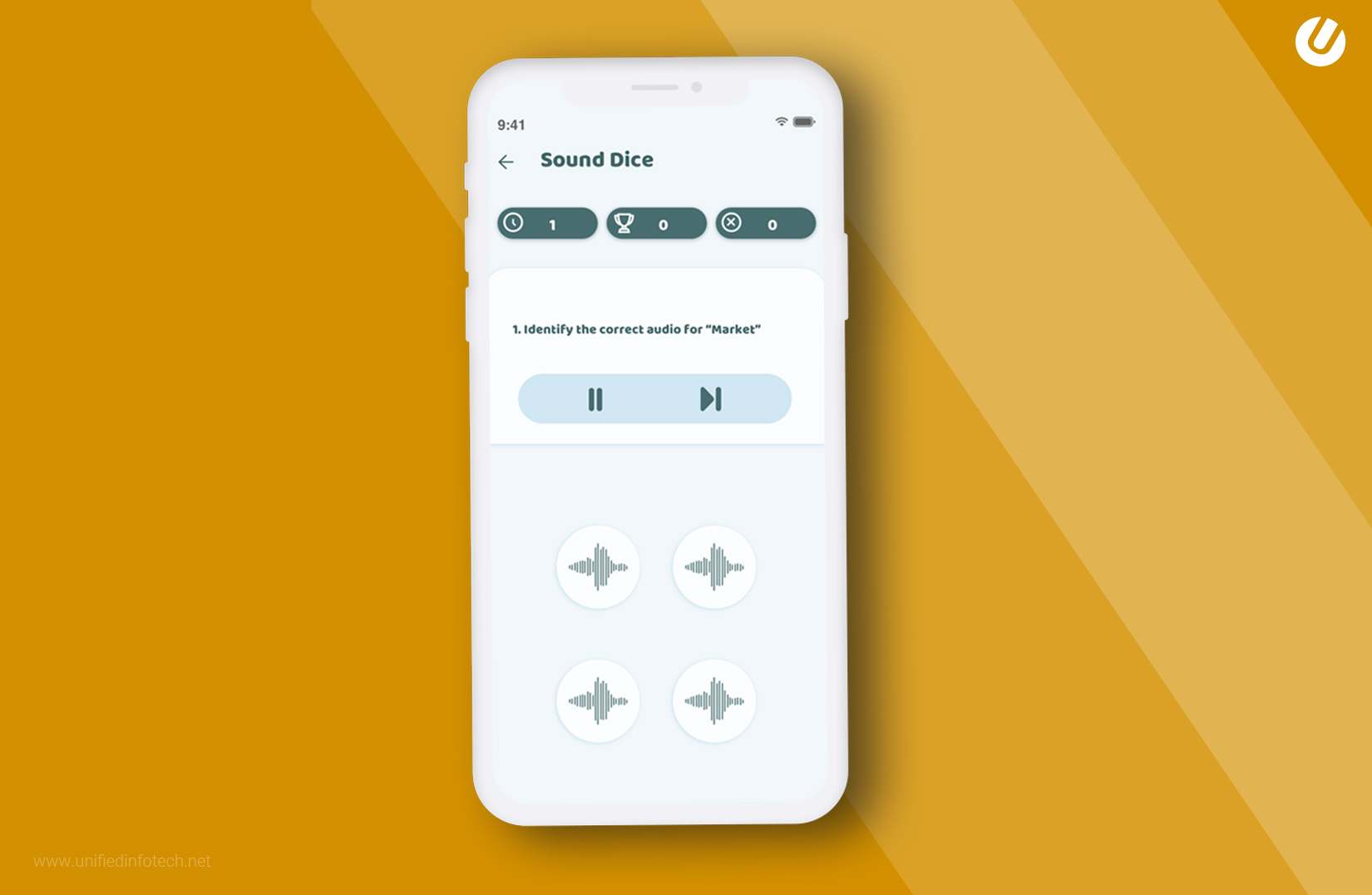
Site Search
How to Create a Language Learning App? We’ve Found out!

Table of contents

Let's talk
Reach out, we'd love to hear from you!
Learning a new language is not a luxury anymore – it is slowly becoming a necessity. Whether you are trying to expand your business, go beyond horizons or create human relations worldwide, you need to have a grab over ‘their language’.
But the good news is that the emergence of easy to use language learning apps are making learning a piece of cake.
Be it Duolingo or Rosetta Stone, they are introducing chatbots and latest tech to make learning easy.

As more and more people recognize this opportunity, more of them are assessing how to create a language learning app. The staggering success of these apps only fuels their inspiration for working on making the perfect language learning app. So hold your breath as I am going to tell you what it takes if you want to make your own language app today.
But first, let’s talk about the current market and your competition.
The Market Scenario For Language Learning Apps
According to Technavio analysis, the global online language learning market to grow at a CAGR of close to 18% during the forecast period of 2019-2023. The AI Powered chatbots are going to be the new trend in online language learning as seen with apps like Duolingo that already has three AI-powered chatbots to help the users learn the languages.
The adoption of AI in language learning effectively is reducing the learning time. The curriculum offered by these apps is turning out to be more relevant to the user’s needs. They tailor made for the user and their preferences when it comes to learning the language.
One of the main reasons for this rising popularity is the convenience it offers.
The cost benefits and flexibility of learning makes it really convenient for the users to learn a new language with an app, rather than going to a class and learn it.
So as you can see, that the market for language app is rising every day. So this will be the perfect opportunity for you to start thinking about how to make a language learning app capitalize on it.
First, let’s take a look at one of the market’s best apps, Duolingo.
Duolingo: The Popular Kid Among The Language Apps
If you are reading this article then you have to be familiar with Duolingo.
In case you are not (which is improbable, but still) then let me tell you that Duolingo is only the most famous language learning app in the market right now. The perfect mix between learning and gamification, they have broken the glass ceiling when it comes to learning through mobile apps.
It may seem like a bit of an exaggeration, but in the first three weeks, the Duolingo Android app was downloaded about a million times.
Duolingo focuses on the gamification approach and direct translation of the words when it comes to their lessons. The user can learn different languages by translating words, phrases, and sentences from their mother tongue and vice versa.
How Duolingo Works?
The bilingual learning process makes it easy and fast to learn another language. With their in-app currency called lingots, and giving badges to the users when they are making progress, the app does an amazing job at engaging the audience.
1. Choosing The Target Language And Evaluating The Skill Level
To begin with Duolingo, the first thing the user needs to do is to choose the target language and evaluate their skill in it. They will get the lessons based on their skill level. If the user has zero skill in that language they can just skip the evaluation process and jump in with the basic lessons.
2. Learn The Basics
Duolingo starts of will the basic words such as apple, man, boy, girl, etc. they would start off with these basic phrases and words and gradually move the user towards more advanced vocabulary.
3. Make Progress
Making progress is pretty simple. You have to finish the lessons and gain XP to level up. Keeping up with the lessons every day will give you a learning streak, and that means more XP and more XP means the user will level up faster. You must think about making consistent progress levels if you want to make your own language app.
4. Keep Leveling Up
Your leveling up speed depends on your learning schedule. You can study every day or once every week. As you level up you’ll earn badges, adding another layer of gamification into the mix.
Duolingo offers the chance to learn more than 30 languages for English speakers. These include – Spanish, French, Italian, German, Japanese, Portuguese, Swedish, Greek, Hebrew and many more.
The best thing about the app is that it is completely free. Sure the free version contains ads, but those ads only appear after every lesson and do not disrupt the user experience. The user can choose to remove those ads with Duolingo plus. You can also repair streak with ‘streak repair’ if you missed one day of lessons.
So are you thinking about how to make an app like Duolingo? Continue reading the article, and you’ll find out.
Factors To Consider While Developing
Just knowing the principles of language learning app making is not enough. There are some factors you have to consider before you take up the development to make your own language learning app.
Like any other learning app, language apps to depend heavily on its user base and their validation. Considering these factors while creating your language app is going to make them like it even more.
How to Make the Learning Right?
As we already said before, language apps are a part of the educational app segment of the market. So obviously there is some key for learning you have to consider while you develop a learning app.
1. Introduce Core Vocabulary Learning
Apps like Duolingo offer the users basic learning from scratch when it comes to vocabulary. You will begin with basic words such as man, woman, girl, boy, apple, etc.

This is a great thing for those who are not familiar with the language and are just starting out with learning.
So make sure to offer better vocabulary options.
2. Hearing Practices
Auditory practice is important when it comes to language learning. You have to give your users a chance at speech comprehension with listening practice. With short videos and audio clips, you can make sure that the users are getting a proper learning experience.
3. Pronunciation / Chatbot
After vocabulary, auditory experience comes the part of pronunciation.
If you are not pronouncing a word correctly, then you can’t really learn the language. So how to do it right?

Well, the best way to integrate pronunciation teaching on your app will be with the use of the audio recording. The Duolingo app has this feature where the user plays the audio of a sentence being said and repeats it back. The app uses the microphone and analyzes whether what the user is saying right or not.
Another way to integrate pronunciation learning is with the use of chatbots. Chatbots are artificial people designed by the developers. With chatbots, users can easily work on their pronunciation and language skills as a whole. As a novice may feel a little shy about speaking to native people in their language, but chatbots will give them a perfect way to get over this shyness.
4. Practice, Practice and Practice
The best way to give the users a chance to practice their language skills is to give them an in-app community of people who are also learning the same language. This way they can speak and practice the language among themselves.
5. Revision to keep learning memorized
When it comes to app-based learning, users will be more inclined to skip lessons.
To prevent this from happening, your app can send push notification to remind them to revise what they have learned already.
How to Keep Users Motivated to Learn Further?
When it comes to app-based free learning, the possibility of people giving up is more compared to paid courses in schools and universities. Which is why you need to keep them motivated when they are using the app so that they feel compelled to come back to your app again and again.
But how are you going to accomplish this when you create your own language app? Let’s look at a few motivational techniques you can use when you create a language app.
1. Introduce Gamification
What’s more fun than learning on your phone?
Playing games on your phone.

But then again, playing games is not exactly productive enough behavior. Still, a lot of people would rather play games on the phone than to learn a new language from an app that is boring and dull. So as a solution, these apps are now combining the learning and gaming process to keep their users interested.
With the gamification of the learning process, you will insert an element of fun in your app users will become addicted to. The user would want to earn more XP for finishing lessons and achieving more milestones.
In-game currency (lingots anyone?) pretty badges, putting clothes on the mascot, or exploring new planets, all are different ways of gamification processes already used by popular apps like Duolingo and Memrise.
What is going to be your gamification process then if you want to make your own language app?
2. Increase Encouragement
A little encouragement goes a long way.

Which is why you need to encourage the users throughout the app. Whether they gave a right answer or a wrong one, keep encouraging them. This can be done with the use of encouraging messages and animations.
Encouragement would help the users to feel better even when they are doing poorly. It will make them feel that they can do better.
3. Bring on Competition
Whether they admit it or not, people are extremely competitive today. Everyone wants recognition, everyone wants to be known for something unique. Competition is the main driving force behind all our actions today.

So it is not surprising when we list competition as one of the main elements for keeping the users motivated. Create a league board, where the users can be ranked according to the amount of XP they gather by finishing lessons.
Hold a monthly, weekly or daily contest where they can compete for a chance to win something- perhaps more in-game currency or getting the premium service for a week for free. The competitive nature of the users will surely bring them back to your app, again and again.
Assisting The User/Student – To Help Them Learn Better
While the language learning app development process is going on, remember that your app definitely needs to be simple enough to use. But at the same time, it is a good idea to have some existing features in your app that users can use to make sense of the app or how to use it.
Not everyone who is going to use your app is going to be tech-savvy. So it is necessary to keep them in mind when you are having your app developed. This way they can use your app even if they don’t have much experience using smartphones apps.
1. Relevant Tips Throughout The App
Your app needs to have the feature of providing the user with relevant tips throughout the interface to help the user understand how it works.
These app tutorials are handy for the student/user to figure out how to start their lessons, where to choose the course from and how to get more XP and beat the leaderboard. However, make sure that the app tutorials don’t become intrusive in the app experience.
Include the option to turn off the tutorials in the settings tab so that the previous users who already know how to use your app don’t get annoyed.
2. One On One Tutoring
Even though learning language from an app seems simple and easy, but they are still one of the most complicated things in this world. Different languages have different rules and regulations and sometimes they can get a little confusing for the users to understand.
In such scenarios, having a personal instructor can help loads, so enable the users to speak and consult with their language instructor when they are in such confusion.
How To Develop Language Teaching Apps
And now we come to the important part of the answer to the question of how to create a language learning app?
There are two steps to the learning app development. The first being the strategizing phase, where you are going to strategize how to develop your app, and then comes planning the features. So let’s dive right in.
Have You Thought of a Strategy yet?
Before you begin planning out the features and monetization models you need to have some proper strategy in place. These strategies will help you to make the most of your app and make it successful in the market.
Right Information From The Right Source
Since this is a foreign language learning app, you need to use the right information from the right sources. If the information used by you is less than accurate, the app will become redundant, not to mention that people will most obviously lose faith in your app.
While we are at the topic of correct information, you should also get some really credible language experts on board. Their presence throughout the project will not only help you to create an app that is useful for enthusiasts, but it will also give your app a sense of credibility in the market.
An Engaging UI/UX Design
Are there any apps in the market that don’t need a good UI/UX design?
The answer is no, there are no apps in the market that will succeed without a good UI/UX design. And just like any other app, your language app also needs a good UI UX design agency as your partner.
Learning a language is already a complicated and boring process (it depends really).
So in such a scenario, the only way you can make language learning appealing is with a great user interface design.
So how are you going to create a good UI/UX design for your app?
Let go of the complex designs and keep it clean and classy. Make the interface easy to use, with right icons at right place. Remember that the UI/UX design is the key to getting more users for your app.
Modular App – Give it a Thought
You are not done with the app once it is developed and launched.
When you are thinking about how to create a language learning app, you also need to think about how to gain and retain clients who come back to the app again and again.
This can only be accomplished with constant updates to the app, adding better course materials, and upgraded technological aspects. Only then your app can stay ahead of the competitors.
But, doing all this will not only cost you money, but it will take a lot of time. Not to mention, that things can go wrong very easily. Which is why you should modularize the app structure.
App modularization is a development technique where you separate functionality into independent interchangeable modules. It means that rather than creating a monolithic app structure, the app is developed with a modular structure, where each module contains everything it needs to complete a specific function.
Hence, it is important that you go with a modular app structure than a traditional one. It will save you from spending a lot of money on the development and upkeep, along with helping you to keep your app updated easily.
Finalize the Language Learning App Features
What are the features you need for your app? How are you going to make it shine in the market full of language apps that are already so popular? The features of any app are the cornerstone for its success, and your app is no different either. Without the right features, your app can fail to become useful to the users.
Learning Process: Make It Interesting
Create a fun and interesting learning process. As we said before, language learning can be somewhat daunting and tedious at the same time. So it is absolutely important that your app’s learning process is fun and interesting while also being enlightening.
All On One Platform
Do not create a fragmented course plan, where in order to learn different aspects of the language, the user needs to download different apps.
If you look at the market you’ll see that apps that offer all on one platform, as in learning how to speak, write and understand the language when being spoken to, are more popular.
After all, you won’t see Duolingo Japanese learning app separately on the app store. Because Duolingo offers all the languages on one app only, making it convenient for the users.
So make sure your app is the one-stop destination for language enthusiast.
Quality Learning: Provide top-notch resources
Many would say that language learning apps are only good enough for vocabulary, but we disagree. We think that language learning app can be as good as any other language course, but only if your app has quality learning resources.
You may feel compelled to add lots of resources to your app, without even checking their credentials. But at the end of the day quality is better than quality. When it comes to learning, it is always more important to have quality resources. So whatever resources you are adding to your app, make sure that is of top-notch quality.
Use Of Illustration
Let’s face it, at the end of the day, a bright illustration can make anything seem better.
Which is why you should add illustrations into your app interface. Aside from making the interface look good, it can also work as an integral element of the user’s learning process. For example, when teaching them the word for apple, rather than just displaying a stock photo of an apple, you can show them a beautiful illustration of an apple. It will get the job done, and make your app look good at the same time.
Best Learning In Less Time
The reason why anyone would install your app to learn a language than enrolling in an institute is that they don’t have the time for a regular course. They can’t keep up with the demand for regular course work, so they would install your app to learn in their own leisure time.
Which is why your app should provide them with quality learning quickly. They are not going to spend hours on end on your app. The most any user will give your app is one hour. And within that one hour you have to make sure whatever they learn from your app, it is valuable and relevant.
Online Student Groups
Last but not least, enable your users to create and join online groups among people from various countries. They would be able to chat and communicate with people who are learning the same language as you, or those who speak the same language as you. You can also add the group competition among the members or group wars among different groups. The winner will get various prizes and achievements.
This will accomplish three goals. Firstly, the users will come together in a community and by speaking in the language they are learning. This will make it easier for them to hone their speaking skills.
Secondly, the competitions will work as an encouraging tool to make the users engage more and more with your app.
And thirdly, with this feature, you will be able to create a worldwide community that will come together based on their diverse teaching and learning together.
So as you can see, a language learning app needs plenty of features to make it functional. However, the cost to develop a language learning app depends on how many features you integrate into your app. To learn more about it, feel free to contact us.
Monetization Model – How to Earn From Your app?
Even though you might be making the app for the people out there, you still need to make money with the app. And that is where the monetization strategy comes to play.
Usually, for the language learning apps, the basic monetization model that works are the in-app advertisements and the subscription-based structure. If we take a look at Duolingo’s monetization structure, then we will see that the app has these two models.
However, the in-app advertisements on Duolingo work seamlessly. The ads are displayed for a few seconds after every lesson, and for the rest of the time you’d use the app, there will be no ads. The interface is clean and free of ads.
As for the subscription-based structure, Duolingo offered a monthly subscription of $6.99/ month. The plus subscription offers an ad-less app experience along with offline courses on mobile, monthly streak repair, and many other features.
So if you are to plan on having in-app advertisements, then make sure they don’t litter the interface. And as for the subscription-based structure, you have to make sure that the subscription offers the users something of value when they pay for it.
Technology Stack
To develop any good app, you need the best tech stack. So obviously, to create a great language app, you need the latest tech stack. Let us give you a brief on that.
- UI/UX design: for front-end development, you’ll need CSS3 and Bootstrap. For the backend, you will need JavaScript, AngularJS, Python, Django, and Ruby. for the android app, the developers have to use Java and for iOS, they will have to use Swift
- Database: the technology used for the database needs to be robust and reliable, as learning requires a lot of data. For the database, the developers can use Postgres, Cassandra, HBase, MongoDB, MySQL, etc.
- Cloud storage: to store the progress of the users, developers can use Amazon data servers and Google cloud storage.
Chatbot Integration
Duolingo became a pioneer in the language learning app market when they added chatbots to their system. The already successful app started to thrive after they introduced three new characters, chef Roberto, Renée the Driver, and officer Ada.
The integration of chatbots surely made the platform more fun and engaging. The users could now go ahead and speak to the chatbots and hone their language skills. This not only helps them to learn the language but also gain confidence while speaking in a foreign tongue.
So if you are thinking about making your own chatbot for your app, then don’t hesitate. It will just be another tool to make your app shine in the line up of language app in the market.
But before you start, remember that creating such a chatbot can be a lot of work, already adding to the work of developing your app. But you can always take the easier way and use natural language engines like Playground by Pandorabots, Wit.ai, or api.ai. You can then train the chatbot to converse in a specific language.
When training the chatbot, you would want to keep the amount of data to be analyzed to a minimum. This way you can make the system easily rather than complicating it by giving it too much data to analyze. The Duolingo chatbots usually prompt the users subtly to enter the right answers or responses. In such a case, they already have a set list of responses, and the user has to choose from one of them,
This approach, however, limited to the user, is the easiest way to build a chatbot for language apps. All you have to do is to feed your chatbot a setlist of responses for every question.
You can also try to integrate speech recognition system in your app and create a voice chatbot, like Mondly.
The app offers the users a voice chatbot, with which the user can converse in real time. This is an amazing way of helping users learn to speak a new language.
But when it comes to voice recognition, there can arise a few problems. Since the users will be speaking a completely new language, their pronunciation can be hard to understand, especially for a voice recognition AI. And that is how conversation can suffer, rendering the experience useless.
So if you are planning on creating a language app, you should definitely go with the integration of chatbot on your app. After all, it is the rising trend in the global learning market right now.
Finally, 7 Major Principles Of Creating A Language App
So now that you know the basics of developing a language learning app like Duolingo, take a look at the following principles needed to make the perfect language app.
- Creating A Two-way Communication Process
- Use Of Proven Learning Process And Resources
- Different Style Of Courses For Different Students
- Use of illustrations and images to enhance learning
- Quick and short lessons to learn faster
- One On One Communication With Language Instructors
- Creating An Online Student Community Within The App
Popular Language Apps In The Market
The market of language learning application does not consist of Duolingo only.
There are plenty of apps that are giving Duolingo fierce competition. And if you choose to make an app such as this, they will also become your competitors. So how about taking an advanced look at the top five language learning apps besides Duolingo?
Memrise
Memrise was founded by Ed Cooke, a Grand Master of Memory, and Greg Detre, a Princeton neuroscientist who specializes in the science of memory and forgetting.
The website launched as a private beta after it won the Princeton Entrepreneurship Club 2009 TigerLaunch competition. 100 users were allowed to sign up to test a non-beta version of the website called Memrise 1.0 on October 1, 2012.
Currently, Memrise is available on both Android and iOS platforms. It aims to combine elements of gamification with an interesting learning process. Whether you want to increase your vocabulary quickly for a trip abroad, or improve your grammar or just brush up your rusty skills, Memrise gives the user the perfect way of doing all that and more.
The app includes features such as offline modes, the chance of interacting with locals who can help the users learn a language in real-time, interactive vocabulary and grammar related games and not to mention, daily goals. With the combination of all these features, Memrise is right there at the top with Duolingo.
Busuu
Created by Bernhard Niesner and Adrian Hilti, Busuu began its journey back in 2008, as a website. The app was launched in 2010.
The name Busuu holds a special significance, as it is named after the endangered language Busuu, spoken in Cameroon. In 2010, the language platform Busuu launched a course on this endangered language to save it from extinction.
With Busuu you can learn 12 major languages such as Spanish, German, French, Arabic, and many more. For each language, the app offers 150 different units. Along with that, there are features such as interacting with locals to sharpen your language skills, get certified with McGraw-Hill Education learning science company. The users also get offline support, grammar tips, and accent training.
So as you can see, Busuu is a close competition if you are planning on creating a language learning app.
Babbel
Founded by Markus Witte and Thomas Holl, Babbel started its journey in 2007. Similar to Busuu, it offers courses on fourteen major languages.
The app includes only paid content, so the users have to subscribe to the service to use it. The features of Babbel include interactive courses for all the language offered on its platform. The courses offered are tailored for both beginners and advanced learners, making it easy for the users to learn no matter where they stand in terms of language skills.
The lessons are bite-sized, taking only 10-15 minutes, which fits right into the busy schedule of the users. The exercises are entertaining and informational, making it a great combination of entertainment and learning. The users can use the speech recognition system to practice their pronunciation. and last but not least, all the learning progress is synced within all the devices the user uses to learn the language.
Going with the paid model instead of ad-based or freemium, Babbel is changing the language app market in a different way.
Beelinguapp
Unlike other language learning application in the market, Beelinguapp takes a different road.
Created by David Montiel, who was born in Mexico and is located in Germany, Beelinguapp works to improve people’s reading skills. The app works with the users to help them not only speak but also read in different languages.
The app contains a library of texts and articles. Once you have set up your account with this app, you can access the texts in its library. After you have chosen a text, you can select languages, the language you want to study and your native language for translation. However, in the free version, you can choose only one to study.
After finding a text you have to download it. Beelinguapp offers two kinds of reading options, side-by-side reading and karaoke reading. On the side-by-side reading, the screen is split in two, showing the same text in two languages you have chosen. And on the karaoke mode, you can hear the audio of the text as you read on.
Using a unique learning process the app has created a new style for language learning apps in the market. While the paid version offers more texts and features, the free version is also an amazing app for the users.
Mindsnacks
Realizing how textbook learning is boring to the mind, Jesse Pickard and his colleagues founded Mindsnacks, a language app that teaches through interactive gaming.
Taking gamification to an entirely new level, Mindsnacks offers to teach essential vocabulary reading, writing, listening and conversation skills in thirteen different languages. And the fun part is that they do this with six interactive games with more than 50 levels. Each level includes 25 words and with relevant pictures and audio clippings of the native speakers.
Unlike other apps, Mindsnacks is perfect for kids to explore new languages. The bright illustrations and games surely create new interest among the kids to learn the new languages.
What’s Your Take?
Despite the criticism, it is still a great idea to learn a language with mobile apps. Sure there may be some limitations, but at the end of the day, it still fits right into the schedule of those busy bees who don’t have time enough to enroll in an institute to learn a new language.
And that is exactly why it will be a brilliant idea to create a language learning app. People are getting busier, and the value of language education is rising every day, which means that more and more people will be relying on language learning service today.

So grab this opportunity and start planning your language app today. Have a question? Shoot us your query and we would answer you right away.


